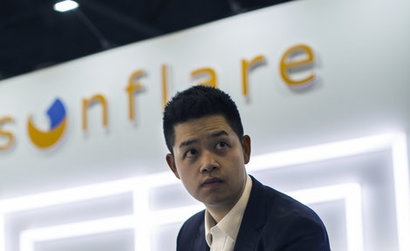
Sunflare panels are made of CIGS (Copper Indium Gallium Selenide) thin film printed on flexible metal backings that can be cut and fitted to any shape. These panels are also 65 percent lighter weight than traditional solar panels and they don't require putting holes in the roof to install them. All you need to do is attach them with specialty roofing tape.
REM talked to Sunflare CEO Phillip Gao to find out more about the company.
Can you tell me about Sunflare and what it does
Sunflare was a pet project of my father about eight years ago. He came over from China with nothing in his pocket and started a furniture company and with the money from that, started to invest in opportunities as they came along. CIGS thin film, which is what Sunflare is all about, was one of those opportunities. We basically funded research and development of the technology in Taiwan and basically got it to the point where we are today.
So, we are in the business of making CIGS solar panels and we sell to both OEMs and to both commercial and industrial applications.
What advantages do Sunflare solar panels have over other brands?
Thin film panels are thin, light and flexible, whereas other solar panels are heavy and big and extremely rigid. The other brands are mostly silicon, either monocrystalline or polycrystalline silicon. The problem with silicon is that it takes an extreme amount of heat to process, and we regard it as very inefficient and so you may not see much savings as far as carbon, in manufacturing the panel. Another aspect is that silicon is extremely brittle, so needs to be encapsulated in glass with an aluminium frame to ensure its rigidity, so if something happens to damage the face of the panel, it's basically destroyed, whereas CIGS is not.
We probably use 50 percent less energy to manufacture than monocrystalline silicon.
What would you say your main target markets are?
Our main focus here in the states is to concentrate on membrane roofs, which is all over the place here in the states and I am sure all over the place in Europe as well. Completely flat rooftops and a lot space for us to play with. Flat roofs generally have weight load issues, you can't put too much weight on the rooftops. With our panels, the mounting on the rooftop is essentially double-sided adhesive versus framing and extra weight. It makes for a very beneficial application.
The other aspect we are working with is OEM integration. Different companies making different products, one example we're working with is a teardrop trailer, which is a recreational vehicle trailer, where we are integrating solar panels on to the rooftop. Wherever the trailer gets pulled to, it will never run out of power. We've been growing that business from there, expanding OEM integration through recreational vehicles, cellphone manufacturers, there's so many different applications actually.
Are you concentrating on the US or looking at other countries as well?
We really want to focus on the US area first, but Asia, particularly China, is one of the bigger focuses for us.
How affordable are the panels?
There's no-one else in the world manufacturing what we have today, the supply chain simply isn't there. While our panels are a little bit more expensive than silicon today, when we see efficiencies in manufacturing costs, we will be significantly cheaper than silicon, to the tune of parity, roughly 40-50 cents per watt right now. We can very easily be the same price as silicon, or cheaper, very soon.
What are your ambitions for the future, say over the next five years or so?
We want a future in which for everything that the sun touches, there's a solar panel beneath it. Solar can become a very large source of energy.
For additional information:

